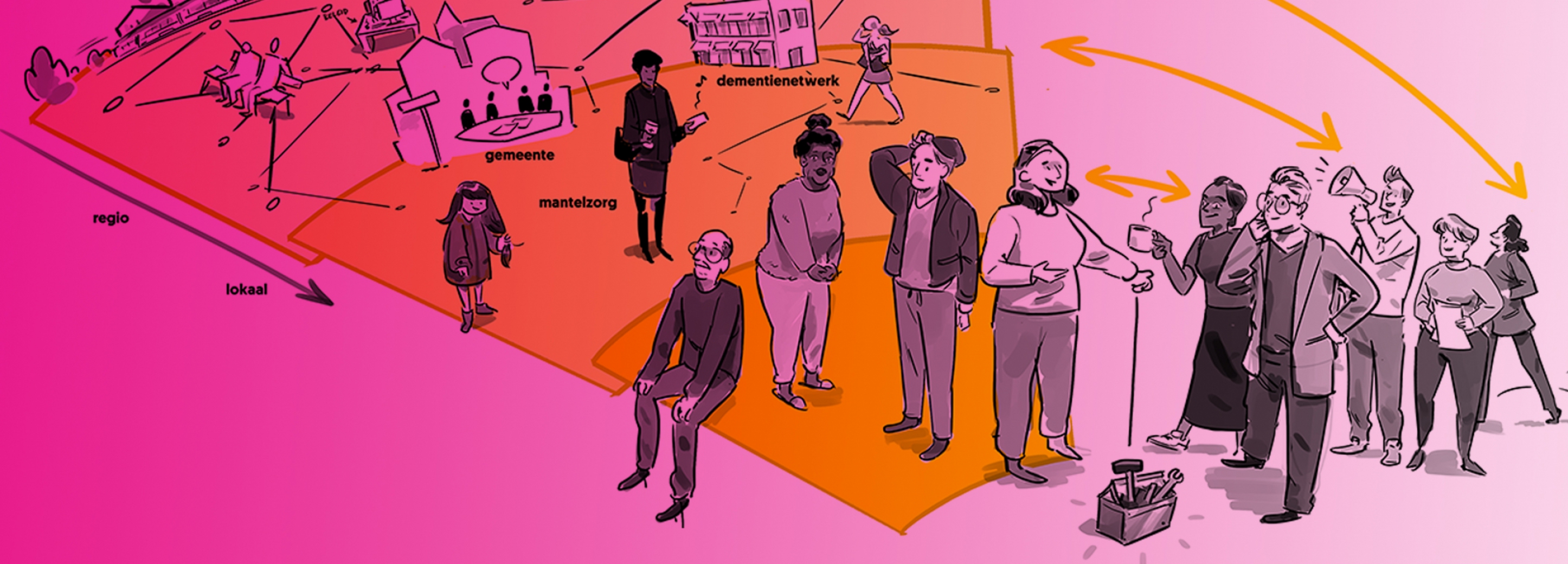Alzheimer Netherlands is committed to one of the greatest challenges of our time: dementia. The number of people with dementia will double to half a million in the next 20 years.
Alzheimer Netherlands offers support, advocacy and information to people with dementia, carers and directly involved parties. The national organization is developing a joint strategy about regional aid for the coming years. They do this together with all 48 local chapters from across the country.
How do you ensure a clear joint strategy that increases mutual cohesion, while at the same time leaving the possibility for regional differences?

Challenge: a shared story with room for differences
How do you develop at a strategy that challenges both the professionals of the national office and the voluntary workers of the local departments? How do you include groups with major differences (including in digital skills)? And how do you give space to the sometimes complex dynamics that these mutual differences entail? In other words: How do you build a shared story that provides connection and clarity, as well as room for individual differences and needs?
Together, Alzheimer Netherlands and Flatland designed a process to develop a joint strategy for regional aid in co-creation with all local departments. With the additional goal: strengthening mutual involvement.

Multi-step process and guidance
The process consisted of three steps: mapping out the contours of the strategy, the digital co-creation meeting and a consolidation session. All local departments joined in during the digital co-creation meeting. Flatland facilitated both the technical side and the chairmanship. This left Alzheimer Netherlands free to focus on what was being said.
The national bureau kicked off with an outline of the strategy and five strategic key issues. This gave direction for all 48 departments. In break-out groups everyone discussed how to contribute to these key issues. How do you fulfill your role as an inspirator and activator of knowledge of dementia to the general public?

Sharing ambitions with each other
The participants shared all kinds of ideas with each other. Can’t we organize courses or information for the general public, so that, for example, we involve young people and the neighborhood in a dementia-friendly community? So that they know what to do if they encounter people with dementia in their daily work? And, how can we give an experienced expert a permanent place in our departments in 2025?
The drawings provided a platform for good examples from daily practice, such as a tea session in the mosque and a world cooking café to promote inclusivity. Seeing all this was inspiring for other departments. It allows for both collectiveness and individual input.

Visualizing creates collectivity
By drawing everything, everyone’s ideas become visible. And that is precisely what is so valuable in group processes. It provides insight into the differences and similarities within the group. And brings equality, because all voices become visible. Also those of the people who don’t yell the loudest. As a participant you can literally see your own voice in the bigger picture.
Instead of people piling up ideas, they build on each other’s ideas because it becomes insightful. They refine each other’s proposals and this is how innovative ideas arise. This method unleashes creativity and contributes to a sense of ownership.

Motivating force for group processes
Visualizing also makes abstract subjects tangible and more concrete. One of the strategic key issues was about promoting inclusivity. Many departments resonate with the desire to get started with this, but find it a challenge to take the first step. In discussions of such themes, visualization can prevent a group from getting bogged down in semantics and definition issues. And that helps align perspectives and get into action mode.
While drawing, the common denominator became more and more visible. The ideas came to life. Result: mutual recognition between the departments, valuable input for the national office and a clear, joint strategy.

Yara Rietdijk
Want to know how we can help your organization? Contact Yara! She likes to think along with you.
Email Yara
Other Flatland Cases

Woonstad - Optimizing customer process in a sprint week
How do we improve customer satisfaction of Woonstad residents? In a sprint week we designed the optimal customer journey together.

C-ARM - Clarifying change processes
With visual storytelling you tell a story. To explain and clarify a new program and get everyone involved!

CCS - Ambitions and annual plan
Superfast strategy development? Possible with visual thinking! We helped software company CCS to define their ambitions and annual plans.

